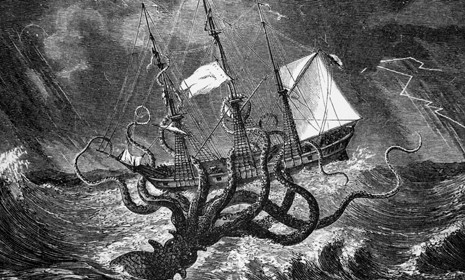A strange, bone-filled lair: Proof the kraken existed?
A paleontologist insists that a massive, octopus-like creature once terrorized the ocean — and turned the bones of its prey into a self-portrait

Did a giant, octopus-like sea monster once rule the seas? Paleontologist Mark McMenamin thinks so. He suggests that a fearsome multiarmed creature, like the one known in folklore as the kraken, was once the ocean's fiercest predator, and feasted on a leviathan reptile called the ichthyosaur. Skeptics are rolling their eyes. Here's what you should know:
Where did McMenamin come up with this story?
In Nevada. Specifically, at Nevada's Berlin-Ichthyosaur State Park. McMenamin claims that the park actually housed the kraken's exotic lair. The proof, he says, is that the fossilized ichthyosaur bones there look a lot like artfully arranged "self-portraits" of the kraken itself.
The Week
Escape your echo chamber. Get the facts behind the news, plus analysis from multiple perspectives.

Sign up for The Week's Free Newsletters
From our morning news briefing to a weekly Good News Newsletter, get the best of The Week delivered directly to your inbox.
From our morning news briefing to a weekly Good News Newsletter, get the best of The Week delivered directly to your inbox.
Umm... really?
Yep. It's true that the fossils have long puzzled scientists. The remains of nine ichthyosaurs — each one "snaggletoothed" and roughly the size of a school bus — are indeed arranged in a "mysterious" pattern, according to Science Daily. Scientists thought it strange that so many ichthyosaur carcasses were in one place. And when McMenamin visited the site himself, "it became very clear that something very odd was going on," he says.
But a giant killer octopus?
Well, the bones seemed "purposefully arranged," says Clint Demeritt at the International Business Times, and "modern octopuses are known to leave piles of bones and shells in their dens." This led McMenamin to theorize that a giant octopus like the kraken captured and killed the ichthyosaurs. A video of an octopus secretly killing sharks at a Seattle aquarium recently gave the octopus "a reputation as a killer," notes Demeritt. And McMenamin says that broken ribs and twisted necks on the fossils suggest a "cephalopod in the Triassic was doing the same thing."
A free daily email with the biggest news stories of the day – and the best features from TheWeek.com
And the self portrait...?
Well, says Science Daily, the remains of the ichthyosaur vertebrae do resemble the "sucker discs" on an octopus' tentacle. "In other words, the vertebral disc 'pavement'… may represent the earliest known self-portrait." Give me a break, says Sarah Simpson at Discovery. "There is no direct evidence of such a monster's existence," let alone any indications of intelligence that would allow it to create its own "self-portrait."
Sources: Science Daily, International Business Times, Discovery, National Geographic
-
 Trump’s poll collapse: can he stop the slide?
Trump’s poll collapse: can he stop the slide?Talking Point President who promised to ease cost-of-living has found that US economic woes can’t be solved ‘via executive fiat’
-
 Sudoku hard: December 7, 2025
Sudoku hard: December 7, 2025The daily hard sudoku puzzle from The Week
-
 Codeword: December 7, 2025
Codeword: December 7, 2025The daily codeword puzzle from The Week